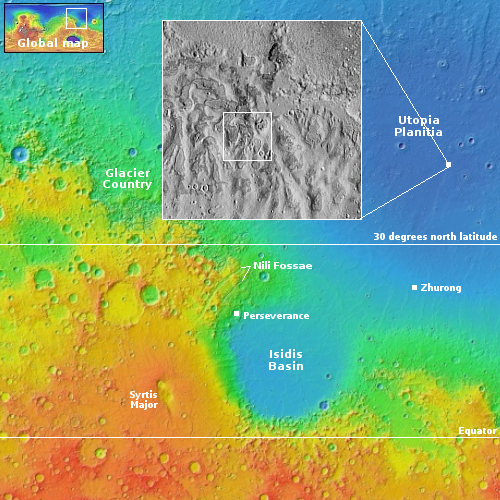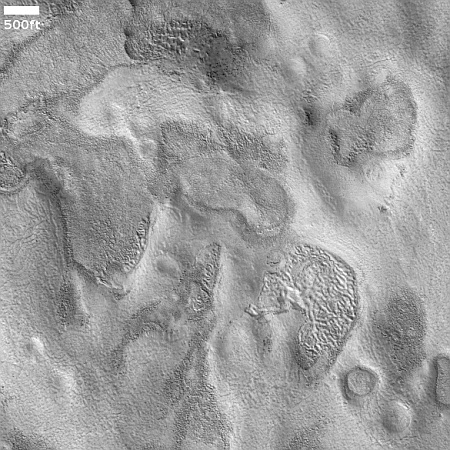The blobby bottom of Utopia Basin
Cool image time! The picture to the right, cropped, reduced, and sharpened to post here, was taken on October 25, 2024 by the high resolution camera on Mars Reconnaissance Orbiter (MRO). Labeled merely as a “terrain sample,” it was likely taken not as part of any specific research project, but to fill a gap in the camera’s schedule so as to maintain the camera’s proper temperature.
The terrain is definitely blobby, with some hollows appears to have ripple dunes suggesting dust and sand. The rounded mounds and some hollows however suggest instead near surface ice or places where sublimation of that underground ice caused the hollows.
Some of the circular depressions might suggest impact craters, but if so, those craters have been significantly modified and softened since impact. Some do appear to be filled with glacial debris.

The white dot on the overview map to the right marks the location, at the very center and bottom of Utopia Basin, one of the largest ancient impact basins on Mars. At 41 degrees north latitude the data generally suggests that near-surface ice is common. In many places in the northern lowland plains the terrain suggest vast ice sheets just below the surface.
Here, if there were ice sheets, they have decayed for some reason, causing this blobby terrain visible today. Though the inset suggests a flow direct either south-to-north or north-to-south, the landscape shows no such trend at all. Instead, the surface goes up and down in a very chaotic manner.
I have no theories but welcome others to attempt an explanation.
On Christmas Eve 1968 three Americans became the first humans to visit another world. What they did to celebrate was unexpected and profound, and will be remembered throughout all human history. Genesis: the Story of Apollo 8, Robert Zimmerman's classic history of humanity's first journey to another world, tells that story, and it is now available as both an ebook and an audiobook, both with a foreword by Valerie Anders and a new introduction by Robert Zimmerman.
The print edition can be purchased at Amazon or from any other book seller. If you want an autographed copy the price is $60 for the hardback and $45 for the paperback, plus $8 shipping for each. Go here for purchasing details. The ebook is available everywhere for $5.99 (before discount) at amazon, or direct from my ebook publisher, ebookit. If you buy it from ebookit you don't support the big tech companies and the author gets a bigger cut much sooner.
The audiobook is also available at all these vendors, and is also free with a 30-day trial membership to Audible.
"Not simply about one mission, [Genesis] is also the history of America's quest for the moon... Zimmerman has done a masterful job of tying disparate events together into a solid account of one of America's greatest human triumphs."--San Antonio Express-News
Cool image time! The picture to the right, cropped, reduced, and sharpened to post here, was taken on October 25, 2024 by the high resolution camera on Mars Reconnaissance Orbiter (MRO). Labeled merely as a “terrain sample,” it was likely taken not as part of any specific research project, but to fill a gap in the camera’s schedule so as to maintain the camera’s proper temperature.
The terrain is definitely blobby, with some hollows appears to have ripple dunes suggesting dust and sand. The rounded mounds and some hollows however suggest instead near surface ice or places where sublimation of that underground ice caused the hollows.
Some of the circular depressions might suggest impact craters, but if so, those craters have been significantly modified and softened since impact. Some do appear to be filled with glacial debris.

The white dot on the overview map to the right marks the location, at the very center and bottom of Utopia Basin, one of the largest ancient impact basins on Mars. At 41 degrees north latitude the data generally suggests that near-surface ice is common. In many places in the northern lowland plains the terrain suggest vast ice sheets just below the surface.
Here, if there were ice sheets, they have decayed for some reason, causing this blobby terrain visible today. Though the inset suggests a flow direct either south-to-north or north-to-south, the landscape shows no such trend at all. Instead, the surface goes up and down in a very chaotic manner.
I have no theories but welcome others to attempt an explanation.
On Christmas Eve 1968 three Americans became the first humans to visit another world. What they did to celebrate was unexpected and profound, and will be remembered throughout all human history. Genesis: the Story of Apollo 8, Robert Zimmerman's classic history of humanity's first journey to another world, tells that story, and it is now available as both an ebook and an audiobook, both with a foreword by Valerie Anders and a new introduction by Robert Zimmerman.
The print edition can be purchased at Amazon or from any other book seller. If you want an autographed copy the price is $60 for the hardback and $45 for the paperback, plus $8 shipping for each. Go here for purchasing details. The ebook is available everywhere for $5.99 (before discount) at amazon, or direct from my ebook publisher, ebookit. If you buy it from ebookit you don't support the big tech companies and the author gets a bigger cut much sooner.
The audiobook is also available at all these vendors, and is also free with a 30-day trial membership to Audible.
"Not simply about one mission, [Genesis] is also the history of America's quest for the moon... Zimmerman has done a masterful job of tying disparate events together into a solid account of one of America's greatest human triumphs."--San Antonio Express-News


